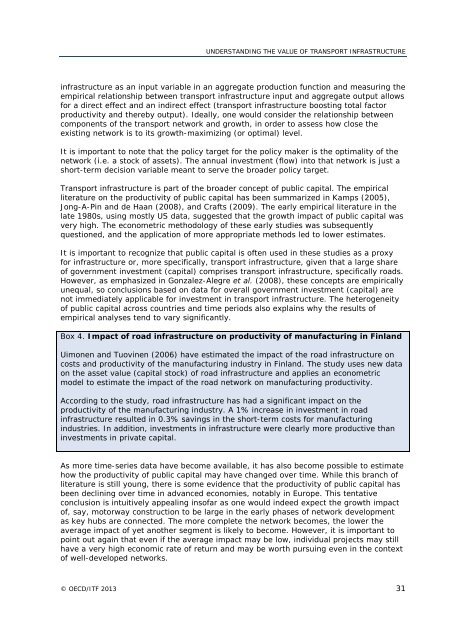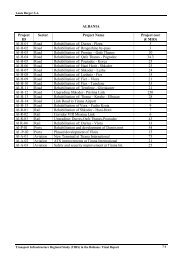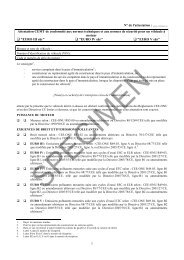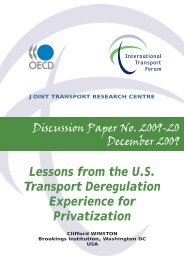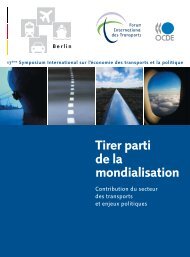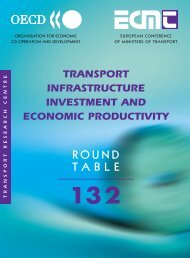Understanding the Value of Transport Infrastructure ...
Understanding the Value of Transport Infrastructure ...
Understanding the Value of Transport Infrastructure ...
Create successful ePaper yourself
Turn your PDF publications into a flip-book with our unique Google optimized e-Paper software.
UNDERSTANDING THE VALUE OF TRANSPORT INFRASTRUCTURE<br />
infrastructure as an input variable in an aggregate production function and measuring <strong>the</strong><br />
empirical relationship between transport infrastructure input and aggregate output allows<br />
for a direct effect and an indirect effect (transport infrastructure boosting total factor<br />
productivity and <strong>the</strong>reby output). Ideally, one would consider <strong>the</strong> relationship between<br />
components <strong>of</strong> <strong>the</strong> transport network and growth, in order to assess how close <strong>the</strong><br />
existing network is to its growth-maximizing (or optimal) level.<br />
It is important to note that <strong>the</strong> policy target for <strong>the</strong> policy maker is <strong>the</strong> optimality <strong>of</strong> <strong>the</strong><br />
network (i.e. a stock <strong>of</strong> assets). The annual investment (flow) into that network is just a<br />
short-term decision variable meant to serve <strong>the</strong> broader policy target.<br />
<strong>Transport</strong> infrastructure is part <strong>of</strong> <strong>the</strong> broader concept <strong>of</strong> public capital. The empirical<br />
literature on <strong>the</strong> productivity <strong>of</strong> public capital has been summarized in Kamps (2005),<br />
Jong-A-Pin and de Haan (2008), and Crafts (2009). The early empirical literature in <strong>the</strong><br />
late 1980s, using mostly US data, suggested that <strong>the</strong> growth impact <strong>of</strong> public capital was<br />
very high. The econometric methodology <strong>of</strong> <strong>the</strong>se early studies was subsequently<br />
questioned, and <strong>the</strong> application <strong>of</strong> more appropriate methods led to lower estimates.<br />
It is important to recognize that public capital is <strong>of</strong>ten used in <strong>the</strong>se studies as a proxy<br />
for infrastructure or, more specifically, transport infrastructure, given that a large share<br />
<strong>of</strong> government investment (capital) comprises transport infrastructure, specifically roads.<br />
However, as emphasized in Gonzalez-Alegre et al. (2008), <strong>the</strong>se concepts are empirically<br />
unequal, so conclusions based on data for overall government investment (capital) are<br />
not immediately applicable for investment in transport infrastructure. The heterogeneity<br />
<strong>of</strong> public capital across countries and time periods also explains why <strong>the</strong> results <strong>of</strong><br />
empirical analyses tend to vary significantly.<br />
Box 4. Impact <strong>of</strong> road infrastructure on productivity <strong>of</strong> manufacturing in Finland<br />
Uimonen and Tuovinen (2006) have estimated <strong>the</strong> impact <strong>of</strong> <strong>the</strong> road infrastructure on<br />
costs and productivity <strong>of</strong> <strong>the</strong> manufacturing industry in Finland. The study uses new data<br />
on <strong>the</strong> asset value (capital stock) <strong>of</strong> road infrastructure and applies an econometric<br />
model to estimate <strong>the</strong> impact <strong>of</strong> <strong>the</strong> road network on manufacturing productivity.<br />
According to <strong>the</strong> study, road infrastructure has had a significant impact on <strong>the</strong><br />
productivity <strong>of</strong> <strong>the</strong> manufacturing industry. A 1% increase in investment in road<br />
infrastructure resulted in 0.3% savings in <strong>the</strong> short-term costs for manufacturing<br />
industries. In addition, investments in infrastructure were clearly more productive than<br />
investments in private capital.<br />
As more time-series data have become available, it has also become possible to estimate<br />
how <strong>the</strong> productivity <strong>of</strong> public capital may have changed over time. While this branch <strong>of</strong><br />
literature is still young, <strong>the</strong>re is some evidence that <strong>the</strong> productivity <strong>of</strong> public capital has<br />
been declining over time in advanced economies, notably in Europe. This tentative<br />
conclusion is intuitively appealing ins<strong>of</strong>ar as one would indeed expect <strong>the</strong> growth impact<br />
<strong>of</strong>, say, motorway construction to be large in <strong>the</strong> early phases <strong>of</strong> network development<br />
as key hubs are connected. The more complete <strong>the</strong> network becomes, <strong>the</strong> lower <strong>the</strong><br />
average impact <strong>of</strong> yet ano<strong>the</strong>r segment is likely to become. However, it is important to<br />
point out again that even if <strong>the</strong> average impact may be low, individual projects may still<br />
have a very high economic rate <strong>of</strong> return and may be worth pursuing even in <strong>the</strong> context<br />
<strong>of</strong> well-developed networks.<br />
© OECD/ITF 2013 31


